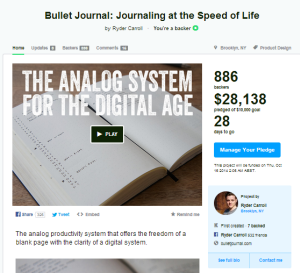 For a couple of months now, I’ve been a convert to a productivity and journalling system called the Bullet Journal developed by Ryder Carroll.
For a couple of months now, I’ve been a convert to a productivity and journalling system called the Bullet Journal developed by Ryder Carroll.
I was a ‘late adopter’ really, because I only discovered the Bullet Journal in July and I gathered it had been around for about a year by the time I stumbled across it.
My experience with this system is possibly another whole blog post. Suffice to say I’m finding it’s a wonderful approach for me, alongside some digital options I’m still using (e.g. for a large contact database) although I’ve now abandoned all other forms of ‘to do lists’. :)
However this post is not about the Bullet Journal itself. It’s about the great tips I’ve picked up for successfully crowd-funding an idea – specifically (in this instance) through Kickstarter.
Ryder Carroll’s Kickstarter project involves taking the Bullet Journal idea to its ‘next level’ – including an enhanced resource website and a special “Bullet Journal specific” notebook published in partnership with Leuchtturm1917, whose notebooks lend themselves very well to this. Here’s a brief chronology of the start of his project:
16 September, 1.45 am (Australian Eastern Standard Time – AEST)
- Announcement received (through Google+) from Ryder about launch of project
- Goal $10,000
- Amount pledged $0
 16 September, 1:56 am (AEST)
16 September, 1:56 am (AEST)
- I make a pledge
- 3 backers, including me
- Amount pledged $90
16 September, 9.58 am (AEST)
- 361 backers
- Amount pledged $11,357
That’s more than $11,000 raised in only 8 hours!!
And it looks like those numbers will continue to climb exponentially. As I write this post on the evening of 17 September, figures now stand at 884 backers and $28,123 pledged with 28 days still to go. All that in less than 48 hours.
So what are the “secrets”?
Well, like most things, when you take a close look there really aren’t any ‘secrets’ at all. Just good, practical, human common sense. :)
Here’s what I’ve learned.**
1) Offer freely to the world something genuinely useful or of value
 This is the foundation and happens well before any Kickstarter project – perhaps even before such a project is even a twinkle in your eye. And your offer should be made without calculation or expectations. Share something – an idea, a resource, an approach, a product – with generosity of spirit and an open heart. People will see right through you if your intent is purely commercial. Oh, they may like what you have to offer – may eventually purchase from you when you’ve got it ready to sell. But Kickstarter is not the platform for you. Go look for a venture capitalist or another funding source.
This is the foundation and happens well before any Kickstarter project – perhaps even before such a project is even a twinkle in your eye. And your offer should be made without calculation or expectations. Share something – an idea, a resource, an approach, a product – with generosity of spirit and an open heart. People will see right through you if your intent is purely commercial. Oh, they may like what you have to offer – may eventually purchase from you when you’ve got it ready to sell. But Kickstarter is not the platform for you. Go look for a venture capitalist or another funding source.
2) Build a strong community around your idea
 Stay involved with all those who are using what you’ve shared or offered to the world (the first step above). Interact with them, support them, continue to offer your time and your passion to them and to your idea. Learn what they like and don’t like about it. Continue to express your appreciation for their engagement with you and their interest in what you have to offer. Use whatever virtual and face-to-face opportunities that are available and will work for you. Be open to other avenues that may appear – often thanks to one or some of your most enthusiastic supporters. :) And make sure you enter into those spaces to engage with people there as well!
Stay involved with all those who are using what you’ve shared or offered to the world (the first step above). Interact with them, support them, continue to offer your time and your passion to them and to your idea. Learn what they like and don’t like about it. Continue to express your appreciation for their engagement with you and their interest in what you have to offer. Use whatever virtual and face-to-face opportunities that are available and will work for you. Be open to other avenues that may appear – often thanks to one or some of your most enthusiastic supporters. :) And make sure you enter into those spaces to engage with people there as well!
3) Be patient
 Before you venture into Kickstarter, allow plenty of time for your ‘fan base’ to build – still without expecting or asking anything in return or pushing a commercial venture. However eager you are to push ahead, think of your idea like a delicate seedling that needs care, nourishment, attention and time before you can transplant it. For example, the Bullet Journal Kickstarter project was at least a year in germination before it was launched.
Before you venture into Kickstarter, allow plenty of time for your ‘fan base’ to build – still without expecting or asking anything in return or pushing a commercial venture. However eager you are to push ahead, think of your idea like a delicate seedling that needs care, nourishment, attention and time before you can transplant it. For example, the Bullet Journal Kickstarter project was at least a year in germination before it was launched.
4) Build your project around an ongoing freely available resource for the world.
 In other words, to appeal to the greatest number of potential backers your project should not be just about something that you will sell or that you plan to sell. Make sure it includes something of real value that you will be offering freely to the world as part of your project. The proposed website enhancement for the Bullet Journal project is a case in point. It’ll cost money to build, so needs funding – but the result will be freely available to the public and continue to support Bullet Journal users in the future. We may assume there could be some monetary gain for Ryder Carroll in his partnership with Leuchtturm and their specifically designed Bullet Journal notebook. And possibly also from other products and services he’ll develop commercially. But a publicly available, free and enhanced resource is a fundamental component of what he is planning to achieve.
In other words, to appeal to the greatest number of potential backers your project should not be just about something that you will sell or that you plan to sell. Make sure it includes something of real value that you will be offering freely to the world as part of your project. The proposed website enhancement for the Bullet Journal project is a case in point. It’ll cost money to build, so needs funding – but the result will be freely available to the public and continue to support Bullet Journal users in the future. We may assume there could be some monetary gain for Ryder Carroll in his partnership with Leuchtturm and their specifically designed Bullet Journal notebook. And possibly also from other products and services he’ll develop commercially. But a publicly available, free and enhanced resource is a fundamental component of what he is planning to achieve.
5) Read all Kickstarter guidelines and policies and plan your project carefully
![]() I’d have put this one as number one in my list, except I figured it should probably go without saying. But in exploring some of the very helpful resources on the Kickstarter site, it’s clear that not everyone takes this important step before submitting a project proposal. :) So in addition to the above tips, it’s crucial to make sure your particular project does fit within Kickstarter guidelines – specifically for creative projects in the worlds of Art, Comics, Crafts, Dance, Design, Fashion, Film & Video, Food, Games, Journalism, Music, Photography, Publishing, Technology, and Theater. It’s probably best to start here with the rules.
I’d have put this one as number one in my list, except I figured it should probably go without saying. But in exploring some of the very helpful resources on the Kickstarter site, it’s clear that not everyone takes this important step before submitting a project proposal. :) So in addition to the above tips, it’s crucial to make sure your particular project does fit within Kickstarter guidelines – specifically for creative projects in the worlds of Art, Comics, Crafts, Dance, Design, Fashion, Film & Video, Food, Games, Journalism, Music, Photography, Publishing, Technology, and Theater. It’s probably best to start here with the rules.
If you’re considering using a crowd funding approach for an idea of your own, take a leaf out of Ryder Carrolls’ book … no pun intended :) … and stick with the process above.
From what I’ve observed, you’ll be far more likely to fund your project – perhaps reaching dizzy heights of success.
And may the force be with you! :)
** A Disclaimer: Please note this blog post and the tips it contains are based on my own understanding of the process Ryder Carroll has gone through for his Kickstarter project. I have not discussed any of this with him and certainly do not claim to be any kind of mind reader! :) The points I’m making are based purely and simply on my own observations of the process.
 Our monthly newsletter
Our monthly newsletter
Speak Your Mind